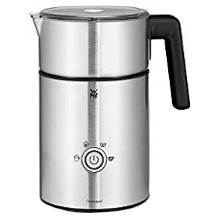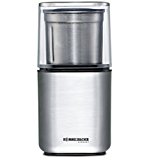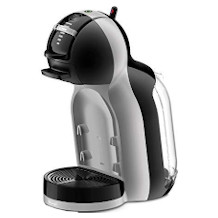Bean-to-cup coffee machine purchasing advice: how to choose the right product
- What You Need to Know
- A fully automatic coffee machine puts an end to the waste produced by filters, pods and capsules. The all-round appliance promises more environmentally friendly coffee enjoyment conveniently and in the shortest possible time at the touch of a button.
- Whether espresso, coffee or cappuccino – thanks to the integrated milk frothing unit, fully automatic coffee machines prepare a wide variety of varieties.
- The freshly ground beans in combination with the perfect brewing temperature and the optimal pressure give the coffee a particularly aromatic taste. Individual settings such as the degree of grinding or the coffee strength perfect the enjoyment according to your own preferences.
- Besides the type of milk frothing, fully automatic machines differ mainly in terms of their grinder, brewing group and capacity.
- Additional features such as an automatic switch-off or a memo function increase convenience in daily use.
- In order not to impair the taste of the coffee, to increase the lifespan of the appliance and also to protect your own health, regular cleaning and descaling of the fully automatic machine is required.
The fully automatic coffee maker: The ultimate for fragrant lovers
For most people, coffee is not just a luxury food, but a passion. This is also evident in the per capita consumption, which has risen in recent years. According to the Statista Coffee Report from 2017, Germans drink 162 litres of coffee per capita per year. This makes the caffeinated pick-me-up the most popular drink in Germany, ahead of water (152 litres) and beer (106 litres). Whether as a ritual to wake up, to recharge one’s batteries for the day or to relax for a moment – the steaming cup of coffee is indispensable in many households. Especially in the early morning, however, it should be as quick and convenient as possible for frahling lovers. At the same time, however, the way it is prepared has become an expression of personal lifestyle and takes on a certain importance in everyday life. Keeping this trend in mind, coffee machine manufacturers created an innovative solution for uncomplicated coffee enjoyment as early as the 1970s and 1980s: the fully automatic coffee machine. Today, it is experiencing a renaissance, which is mainly due to the current lifestyle in the western hemisphere.
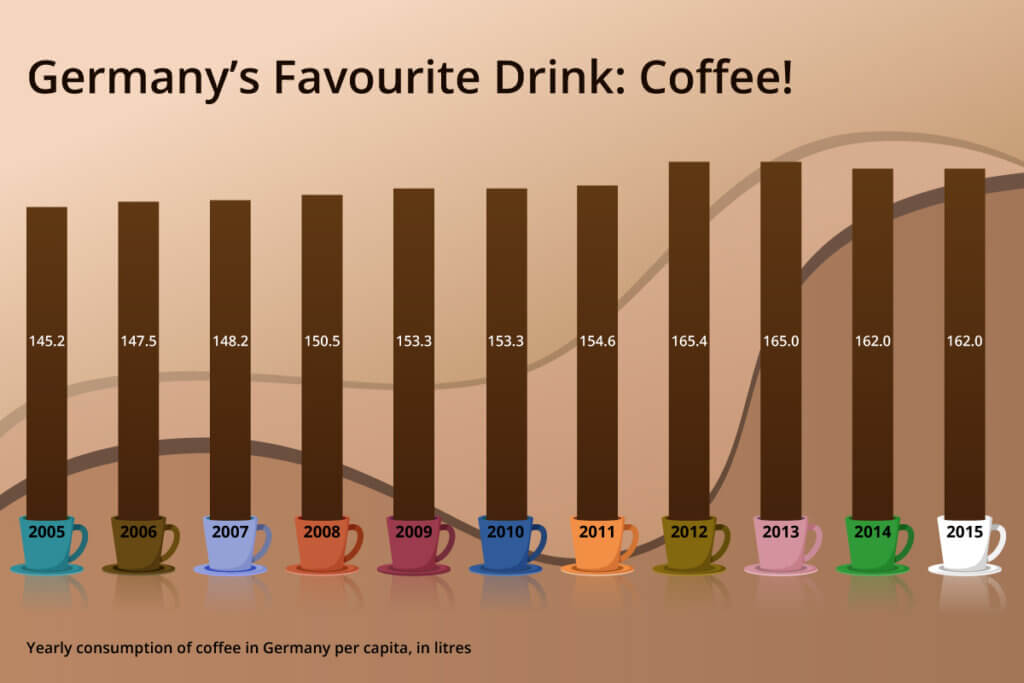
The all-round device is not only suitable for offices, but also for private individuals who occasionally want to enjoy a high-quality cup of coffee. Whether espresso, latte macchiato or latte: the desired variety lands in the cup at the touch of a button. The machine works its caffeinated magic and relieves consumers of much of the preparation work. Compared to a filter machine, it has both a water tank and a bean supply. Since a fully automatic machine does not simply brew powder, but also grinds beans beforehand, it allows fragrant lovers to enjoy their coffee particularly quickly, conveniently and freshly to boot.
Barista – The bartender of cafés
Barista is the term for an employee in a café who is responsible for preparing the speciality coffees. The word comes from Italian and actually means “bartender”. In Germany, however, people tend to equate the focus of the job with the art of preparing coffee.
How does the caffeine kick work at the touch of a button?
The origins of modern fully automatic coffee machines lie in the commercial self-service machines, which offered soup and sweet drinks in addition to coffee. In the course of technical innovations, this developed into a more affordable, more compact format that private households can also integrate into their everyday lives. A fully automatic coffee maker is therefore nothing more than a mechanical barista that takes care of everything from grinding the coffee beans to cleaning them fully automatically. Many devices are also able to froth milk with the help of steam to produce milk variations such as latte macchiato and cappuccino in addition to classic coffee or espresso.
A fully automatic coffee machine basically consists of the components grinder, hot water generator (also called flow heater), pump and brewing group with drive. In addition, a control unit controls the coffee and milk preparation: it allows the individual setting of cup size, brewing temperature, water hardness and powder quantity (more detailed explanations follow from the third section).
After switching on the unit, the following processes usually take place:
- The machine warms up and an automatic cleaning cycle starts.
- After selecting the desired beverage, the machine grinds the beans; it conveys the powder obtained to the brewing group, where it presses the powder.
- The pump then delivers a defined quantity of water to the inlet of the brew group, which heats it.
- The used powder automatically lands in a collection container and the coffee flows into the cup.
Milk container, milk frother and water connection
Depending on how the machine is designed, the process of making coffee and milk is a little different. There are three types of fully automatic coffee machines:
Fully automatic coffee machines with milk container
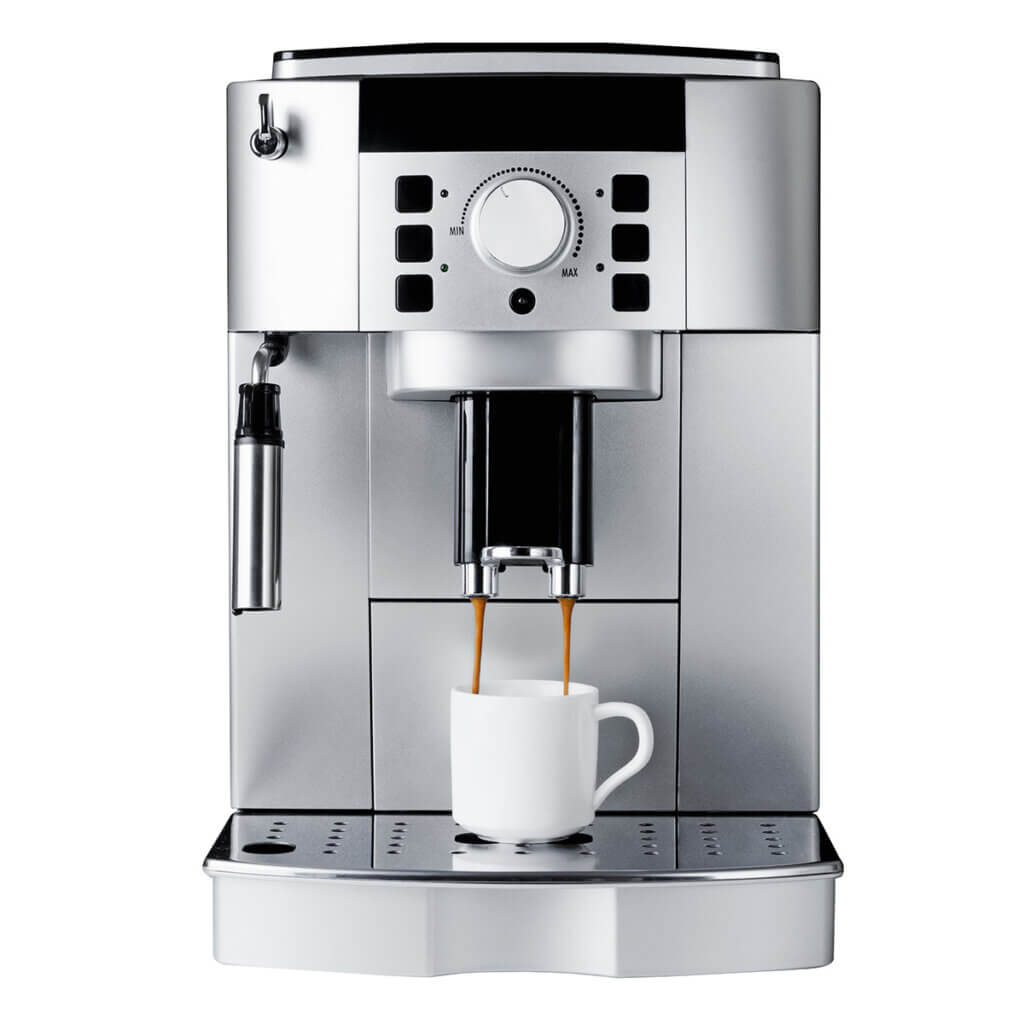
A container integrated inside the machine stores the milk with the help of a separate cooling unit and keeps it fresh – at least as long as the machine is connected to a power source. A hose on the container feeds the milk to the frothing unit when needed.
Application: This type is equally suitable for offices and private households. However, cleaning the milk hose is complicated.
Fully automatic coffee machines with milk frother
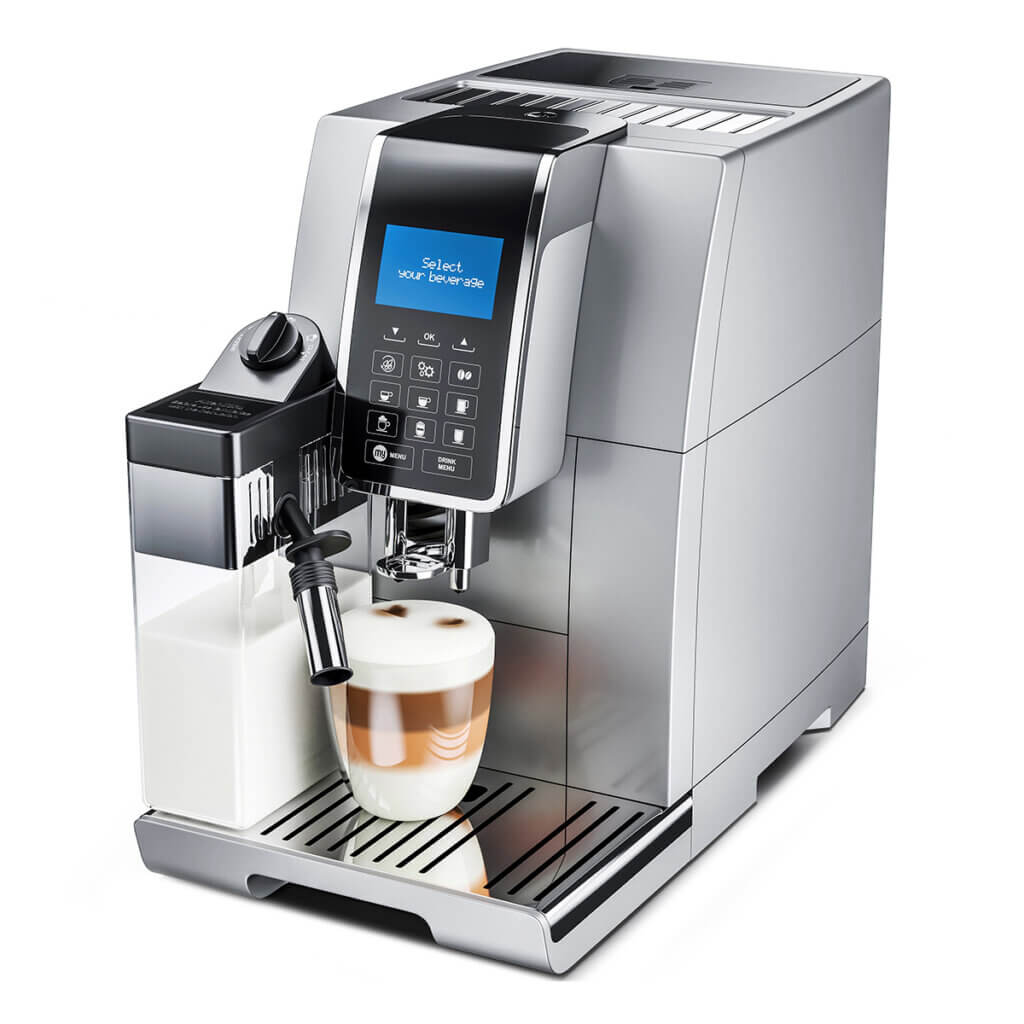
The milk frother is either integrated directly into the machine or is located on the side of the machine in the form of a nozzle. It automatically froths the milk at the touch of a button or rotary control.
Application: This type is suitable for anyone who values an affordable option as much as variety when it comes to coffee preparation.
Fully automatic coffee machines with water connection
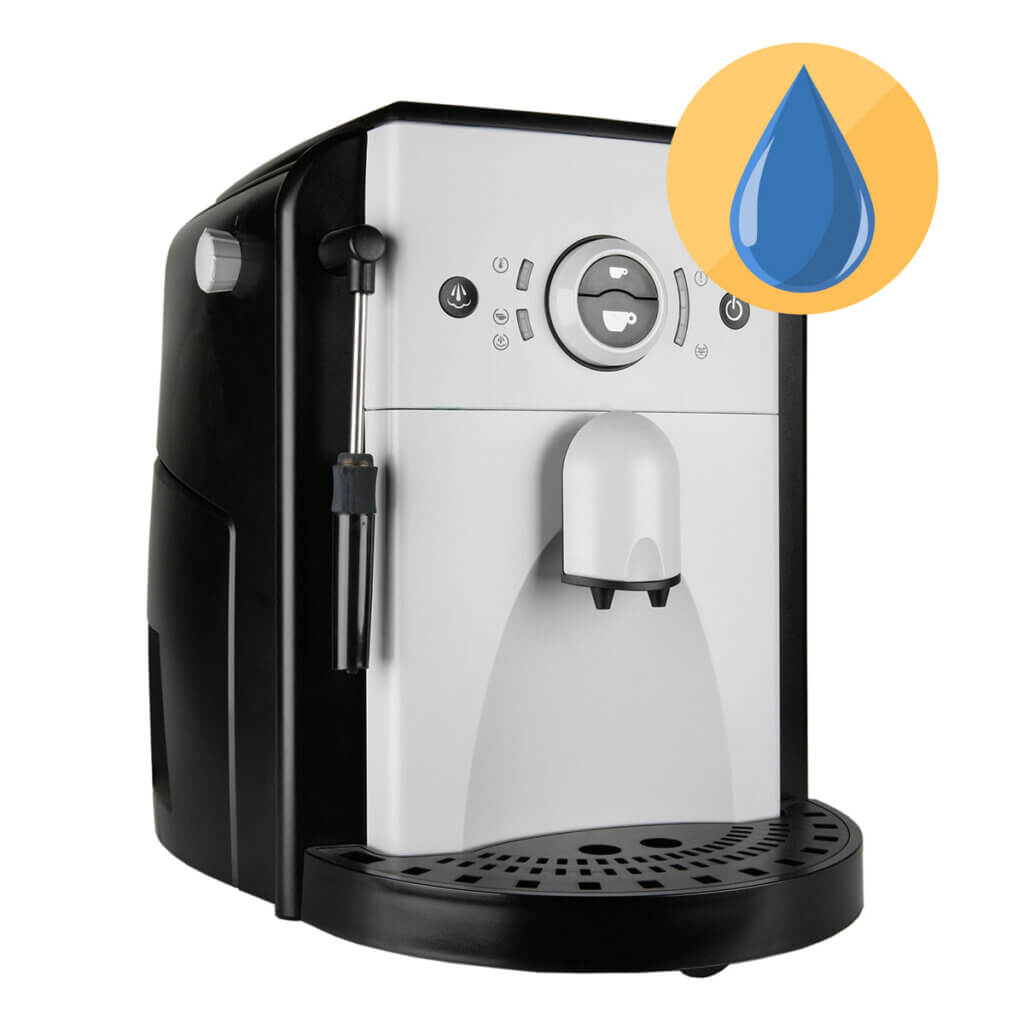
The somewhat larger units do not need to be filled with water, but draw it directly from the tap. The separate connection requires a location close to a fresh water supply as well as the permanent securing of the water supply.
Application: This type is particularly suitable for restaurateurs who produce coffee in larger quantities.
Fast, convenient and versatile: the benefits of a fully automatic coffee machine
The coffee machine market now offers a wide range of appliances for every type of household. In addition to fully automatic machines, there are classic filter machines, espresso pots, portafilter machines as well as capsule and pad machines. The fully automatic machine offers the greatest variety, because basically any type of coffee can be prepared with this machine – and in no time at all. There is no need to “wait and see”: Once users have filled the machine with water and coffee beans, they don’t have to worry about anything else for the time being. The coffee machine takes care of the most important processes, from grinding to brewing to pouring, fully automatically. Only the powder container and overflow tray need to be emptied occasionally.
Fully automatic coffee machine versus filter machine and co.
The quickest way to prepare coffee is undoubtedly with instant coffee. Consumers pour water over a heaped coffee spoon, stir the mixture, and they can drink a cup of coffee – but refined enjoyment looks different. So what other ways of making coffee exist, and what are the advantages and disadvantages of the different types?
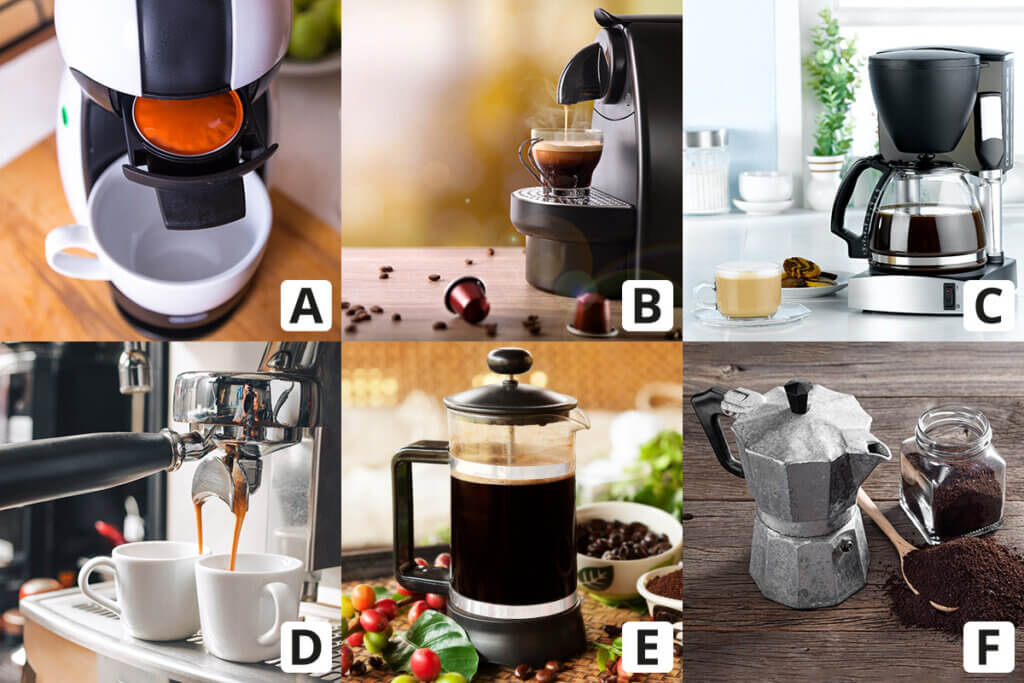
The classic: the filter machine
The filter machine was the first electric alternative to making coffee by hand, making it the classic machine par excellence. It now even has a certain retro charm. It is still a popular and uncomplicated ritual to manually insert filter paper and powder to slowly brew the coffee. The machines contain a heating element that heats the water in the tank and then allows it to seep over the coffee powder. The finished coffee is collected by a jug, which is usually placed on a heating plate to keep the coffee warm.
One advantage of the filter machine is that it makes a larger quantity of coffee in one operation. In contrast, a fully automatic coffee maker makes a maximum of two cups at a time. Furthermore, a filter machine is more robust and less susceptible to malfunctions because it does not have a grinder. With a fully automatic coffee maker, a single stone is sometimes enough to block the grinder. Those who have less space available in the kitchen also benefit from the slim design of the filter machine. At 10 to 80 euros, it is significantly cheaper than most other types, with the exception of the French press or espresso pot.
Although users decide for themselves how much coffee powder to add, depending on the desired strength and number of cups, it can still happen that the coffee tastes bitter. Unlike a fully automatic coffee machine, a filter machine does not generate any pressure, which means that the aromas of the coffee cannot develop as much. In addition, the longer contact of the powder with the water means that more bitter and tannic substances get into the coffee. With a fully automatic machine, for example, the brewing process takes no more than 30 seconds, which makes the coffee, which is thus less heavily loaded, more digestible. In addition, with the filter machine, in contrast to the fully automatic machine, no other variety variations are possible apart from black coffee.
Pro Points
- Easy handling
- Larger quantities of coffee in one pass
- Robust and largely interference-free
- Compact design
- Uncomplicated care and cleaning
- Inexpensive to purchase
Drawbacks
- Longer waiting time
- Sometimes bitter taste
- No coffee variety
- Filter paper necessary
The Hipsters: French Press and Espresso Pot
If you are looking for a compact coffee maker that does not require a power connection, it is best to go for a French press or an espresso pot. Since these two types of pot, like filter machines, have their own individual charm and can be purchased very cheaply (10 to 50 euros), both the budget-conscious and the trend-conscious get their money’s worth.
Turkish mocha
A special form of wake-up drink is Turkish coffee or mocha: in the traditional way, very finely ground coffee is heated in a metal pot with water, sugar and cardamom until a fine foam forms.
With the French press or press pot, users pour in coarsely ground powder and pour hot (not boiling!) water over it. They then stir the mixture, let it steep before gently stirring the powder again, and gently press the press plunger down so that the liquid coffee remains above the plunger. In contrast, the espresso pot, also called a maccinetta, consists of a lower part that is filled with water, an attachment for fine espresso powder above it, and a jug that is in turn screwed onto the two lower parts. To get the brewing process going, users simply heat it on a hotplate.
Since there is no filtration, the essential oils remain in the coffee, which makes it particularly aromatic. Here, too, the taste can be changed by adjusting the grind, the amount of powder and the brewing time. However, some people find the coffee grounds somewhat unpleasant, as they end up floating in the cup, which is almost unavoidable. In addition, the preparation is much more time-consuming than with a fully automatic coffee maker. So if you are in a hurry, it is better to use the more convenient and quicker option.
Pro Points
- Compact, transportable size
- Conservation of essential oils
- No power supply necessary
- Uncomplicated care and cleaning
- Inexpensive to purchase
Drawbacks
- Only small quantities of coffee possible
- Sometimes coffee grounds in the drink
- No coffee variety
The professional: the portafilter machine
When using a portafilter, users put finely ground espresso powder into the portafilter and press it evenly with the so-called tamper, the coffee tamper. They then clamp the portafilter to the brew button, whereupon hot water is forced through the powder at high pressure. Unlike filter coffee machines or French presses, most portafilters have a hot steam nozzle that allows milk to be heated or foamed. In addition to espresso, other coffee creations such as cappuccino or latte macchiato can be made.
Due to their unadulterated, aromatic taste and creamy foam, not only gastronomes but also fragrant lovers in private households appreciate the traditional machines. With a price range from 80 to 5,000 euros, there is something to suit every consumer. In contrast to fully automatic coffee machines, which make black bliss within a few seconds, the motto here is “good things take time”. In addition to the coffee preparation itself, the subsequent cleaning also takes a lot of time. If you value high-quality coffee but don’t want to spend a lot of money on it, you’re better off with a fully automatic coffee maker. They deliver very good quality for a lower purchase price.
Pro Points
- Traditional coffee enjoyment
- Fine crema
- Coffee variations thanks to the hot steam nozzle
Drawbacks
- Elaborate cleaning
- Somewhat expensive to purchase
The convenient ones: Capsule and pad machine
Capsule and pad machines (30 to 100 euros) are worthwhile for anyone who wants to prepare their coffee quickly and conveniently but does not want to set up a large-format fully automatic coffee machine. In terms of speed, they are in no way inferior to fully automatic coffee machines. Users simply place an aroma-sealed capsule or pad in the machine, select the desired portioning and let hot water run over it automatically. Capsules are pierced immediately before brewing.
Unlike fully automatic coffee machines, the powder in a capsule or pad machine is not pressed at a pressure of 9 to 15 bar, but at a full 19 bar. Conveniently, most machines are equipped with a milk foam unit, so that special coffee specialities are also possible. In addition, some machines even allow you to make tea and cocoa. This is an advantage over fully automatic machines that should not be underestimated: Capsule and pad machines are much more compact and fit even into small kitchen niches.
While coffee pods are enclosed in filter paper, capsules are usually made of aluminium and, depending on the manufacturer, a lot of plastic. Both are filled with the appropriate amount of coffee for one cup. These are therefore single-serve machines. The capsules or pods are usually not compatible with other brands, are very expensive compared to coffee beans (between 14 and 36 cents per capsule or pad) and produce a lot of waste. With fully automatic coffee machines, on the other hand, the follow-up costs are limited, as coffee beans are much cheaper to buy than pods and capsules. Moreover, fully automatic coffee machines are more environmentally friendly because they only produce compostable waste, namely coffee grounds.
Pro Points
- Fast and uncomplicated handling
- Compact design
- Coffee variations thanks to milk foam unit
Drawbacks
- Considerable waste production
- High follow-up costs
- Only single portions possible
A question of price
Although capsule and pad machines are cheaper to buy, they are subsequently expensive. While the price per cup averages 25 cents, a cup of coffee from a fully automatic machine costs only about 17 cents. With a filter machine or French press or espresso pot, the average price of 10 to 12 cents is still somewhat lower. A cup of coffee from a portafilter machine is more in the middle range at 13 to 20 cents.
While a few years ago the machines were still unaffordable for most private individuals, consumers can now get a reliable fully automatic machine from 250 euros. Upwards, the price range is very wide, which is related to various criteria such as the capacity of the machine, the range of functions and the quality of the grinder.
For connoisseurs with the necessary budget, the purchase of a high-quality machine with sophisticated features is worthwhile. Restaurateurs depend on a particularly high standard of quality to satisfy their customers and prepare a large quantity of coffee. Professional fully automatic machines are made of very high quality, for example stainless steel, and are equipped with extensive features. On the other hand, those who only drink coffee at home from time to time can also opt for a less expensive model.
| Occasional drinker | 250 to 350 euros |
| Frahling lovers | 350 to 650 euros |
| Gastronomes | 650 to 1,500 euros |
Attention, noisy grinding: finding the right grinder
In addition to the coffee beans used, the inner values of the fully automatic coffee maker also play a decisive role. One of the most important components is the integrated grinder, which freshly processes beans into aromatic powder.
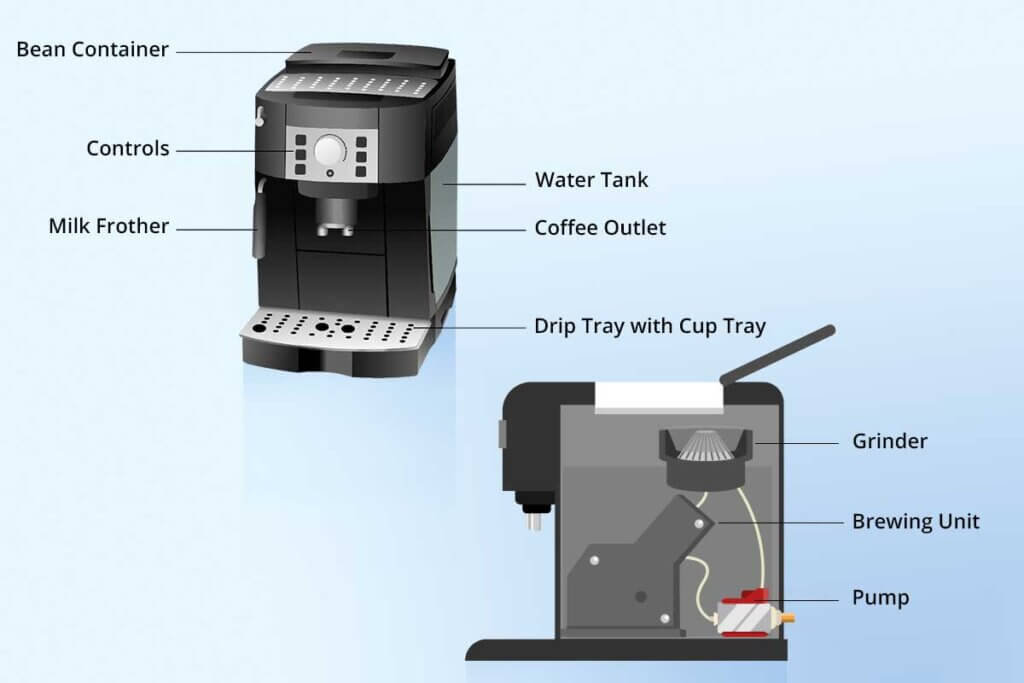
From beating to rolling: the working method
On the grinder itself, the degree of grinding, i.e. the fineness or coarseness of the powder, can be adjusted on most machines. However, the way the grinders work is crucial for the taste, because they process the coffee beans differently depending on their design. Modern machines usually have a cone or disc grinder. The low-cost impact grinders and the high-quality roller grinders, on the other hand, are rarely used.
The impact grinder

A percussion grinder pulverises the coffee beans into an uneven grain with a rapid rotary motion. This is more a destruction of the coffee bean in a chopping motion than a grinding process. On the one hand, the hard contact of the beater blade with the bean generates heat, so that the oils contained in the coffee are converted into bitter substances. On the other hand, the cone-shaped grinder produces a high noise level. In addition, this design does not allow the grind to be adjusted due to the fixed blade spacing, which means that the intensity of the coffee flavour cannot be changed. Apart from the low purchase costs, there are no advantages. Due to the numerous disadvantages, this grinder is hardly ever used in modern fully automatic coffee machines.
The disc mill
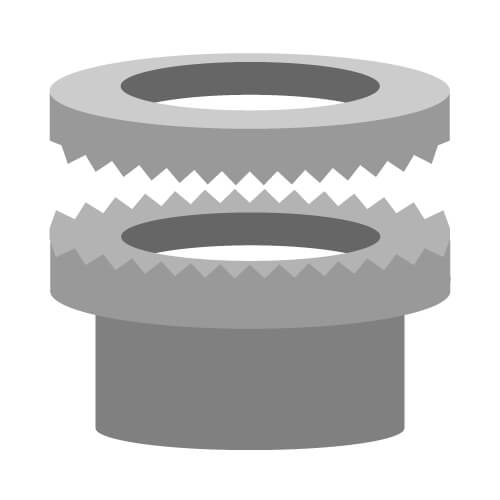
Most fully automatic coffee machines have a disc grinder, which is not very durable but delivers good results. Unlike the impact grinder, it does not work with cone-shaped grinding units, but grinds the beans between two oppositely rotating, toothed grinding discs at a very high speed into fine powder. With the help of centrifugal force, the homogeneously ground powder moves further and further outwards until it emerges from between the discs. Although the coffee powder also heats up slightly here, which causes it to lose some of its aroma and releases bitter substances, high-quality models work with a reduced number of revolutions so that no heat is generated by the friction. In contrast to the impact grinder, it is possible to adjust the grinding degree with the disc version by changing the distance between the two grinding discs.
The cone grinder
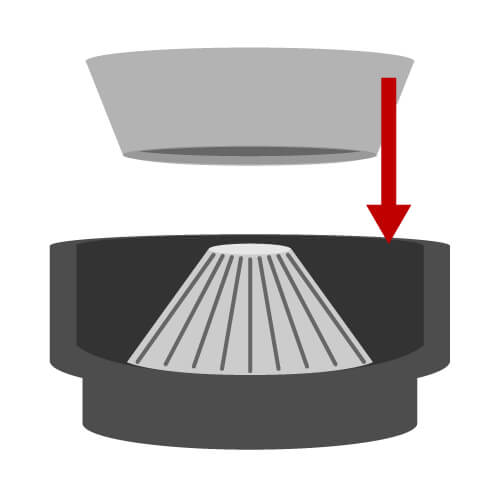
The particularly durable cone grinder allows precise adjustment of the grind by adjusting the distance between the discs. It grinds the coffee beans in a small recess between the finely toothed cone and the likewise toothed funnel. In doing so, it works by gravity rather than centrifugal force like the disc grinder. As soon as it is finely enough ground, the powder falls through to the bottom. Due to the uniform grain size, the coffee gets a particularly intense aroma. In addition, thanks to the lower rotational movements, no high temperatures are generated, which not only protects the aroma but also the grinder itself. Another advantage of the lower speed is the moderate noise level.
The roller mill
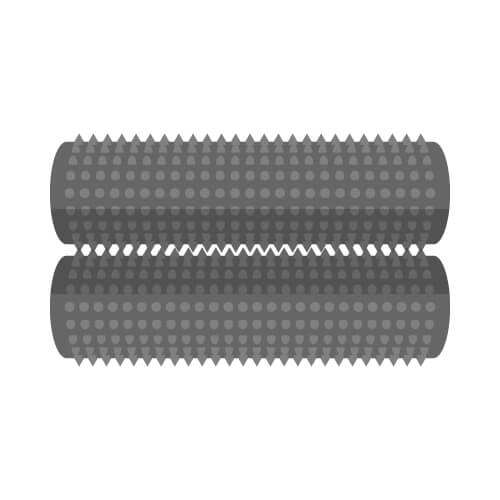
Probably the highest-quality and most powerful variant is the roller grinder, which provides the best coffee enjoyment. At the same time, however, it is also the most expensive grinder and is therefore found in very few fully automatic machines. As it gently grinds the coffee beans into powder between two very slowly rotating rollers, there is hardly any heat. This preserves the full aroma of the coffee. Thanks to its high quality, the grinder is also suitable for frequent use.
Stainless steel or ceramic? The material
In addition to the design, the material is also relevant for the longevity of the grinder. Grinders made of ceramic or steel are usually found on the market. Ceramic works more quietly, is extremely robust, tasteless, rust-free and emission-free. Since it does not absorb heat, the coffee aroma remains unaffected. Steel also has these positive properties, but produces a higher noise level. Grinders made of hardened steel are less prone to breakage and very easy to clean, but they can wear out over time. However, since steel is cheaper, it is found in most fully automatic coffee machines.
The noise level
A decisive purchase criterion is also the noise level when grinding the beans. The higher the quality and precision of the grinder, the quieter the fully automatic machine.
The heart of the fully automatic coffee machine: The brewing group
The heart of the fully automatic coffee machine is the so-called brewing group, i.e. the place where the hot water is pressed through the compressed coffee. As the dissolved aromatic substances combine with the hot water, the coffee is created. While consumers do not necessarily need the highest-quality grinder, they should, in turn, place high demands on the brew group.
Depending on the manufacturer, the brew group is either made of plastic or metal. However, the most important decision criterion is the way it is installed in the machine, because this affects the maintenance effort and hygiene of the fully automatic machine. A distinction is made between the following types of construction:
- Removable brew group: The brew group can be effortlessly taken apart and rinsed under running water, which makes cleaning much easier. If it is defective, it is also no problem to buy a spare part and replace it without the help of a technician.
- Fixed brew group: Cleaning requires either the machine’s own cleaning programme or special tablets, so many users tend to clean their fully automatic machines irregularly out of convenience or forgetfulness.
It is therefore important to make sure that the brew group is removable so that it can be cleaned as easily and thoroughly as possible. This in turn increases the life of the machine. These are mainly found in high-quality models.
The biggest difference between an ordinary filter coffee machine and a fully automatic machine is the fuller aroma, which develops best through pressure. For the perfect espresso, for example, between 7.5 and 9 bar are necessary. This is the only way to dissolve the right amount of bitter substances. The maximum pump pressure of a fully automatic machine is usually 15 bar – more than enough for any discerning connoisseur. In the course of the brewing process, for example, the water is heated to about 90 degrees and pressed through the ground beans at about nine bars. This produces a relatively strong coffee concentrate and a fine foam – the crema.
Size matters: The capacity
An automatic coffee maker has two different containers, each with a different capacity. The capacities of the bean container and water tank are a decisive purchase criterion primarily because it influences the frequency of refilling. Accordingly, the capacity should be matched to the demand: The higher the coffee consumption, the larger the capacity should be.
However, since the coffee beans lose their aroma over time and the long storage of water in the tank also promotes the formation of bacteria, the capacity should not be chosen too large.
The bean hopper
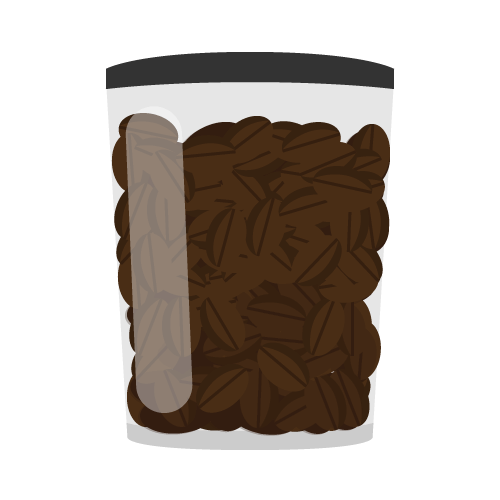
The filling capacity of smaller to medium-sized machines is usually 250 grams and thus corresponds to the standard commercial packaging size of coffee beans. Larger fully automatic machines can hold up to 1.3 kilograms and are best suited for consuming larger quantities of coffee, for example in offices.
The water tank

While smaller fully automatic coffee machines only hold one litre of water, large machines have a capacity of three to five litres. Commercial machines even hold more than five litres of water. Ultimately, it depends on the daily coffee consumption:
| Number of cups per day | Capacity |
| 2 to 3 | 1 litre |
| 4 to 8 | 2 to 3 litres |
| 10 to 20 | 3 to 5 litres |
| Over 20 | From 5 litres |
Consequently, anyone who only drinks a cup of coffee occasionally should, for example, choose a fully automatic machine with a bean container capacity of 250 grams and a water tank capacity of one litre.
Comfortable filling
A removable water tank can be detached from the coffee machine in one easy step and easily refilled or cleaned without having to turn the machine.
The range of functions for convenient handling
In addition to the grinder, brew group and capacity, there are other important functions and features to consider before buying a fully automatic coffee machine. But which features are really useful, for example to make handling easier, and which accessories can be safely dispensed with?
Milk foam at the touch of a button: milk foam frother versus cappuccinatore
Fully automatic coffee machines now offer a wide range of options for frothing milk. While a milk frothing nozzle, also known as a steam lance, is more commonly used on inexpensive machines, milk frothing systems or so-called cappuccinators are found on high-priced models. Of course, the one-button principle of the single-suction system speaks for convenience, as the milk is automatically drawn from the milk carton or jug via a hose, heated and frothed. If the container is removable, users can easily store the milk in the refrigerator so that they do not have to throw it away if it has been sitting unused at room temperature for some time. High-quality milk frothing systems even allow the user to adjust the foam consistency and temperature.
A milk frothing nozzle is also located on the outside of the machine. With this system, users hold a cup or other container of milk separately under the nozzle and let it froth.
Enjoying coffee by button, touchscreen or app: the operating system
The operating system consists of either a multifunctional rotary switch, individual buttons or a touchscreen display. The latter enables convenient operation by touching certain sensor points. In the meantime, even control via app is possible. However, a small display without touch function or warning lights are also sufficient for most consumers. The decisive factor is that the machine can be operated easily and intuitively. If complicated button combinations have to be selected in order to produce a simple cup of coffee, the appliance will lose its appeal over time.
In addition to ease of use, the individual setting options are also important. At least the adjustment of the bean grind, the coffee strength and the amount of water or cup size should be part of the standard repertoire.
Robust, easy to clean and visually appealing: the material
The material of the fully automatic coffee machine is a decisive purchase criterion, on the one hand for visual reasons, and on the other for reasons of robustness and thus durability.
- Aluminium: A housing made of aluminium is rustproof and easy to clean, but also more susceptible to scratches than stainless steel.
- Stainless steel: If you prefer a noble look, opt for hygienic stainless steel, on which no bacteria can settle, but fingerprints are quickly visible.
- Chrome: Applied primarily as a protective layer against corrosion, the metallic mirror-like chrome is scratch-resistant thanks to its hardness, but requires more cleaning than other materials.
- Plastic: Plastic may be cheap, easy to clean and robust, but it is questionable from a health point of view. It also becomes statically charged, which causes the ground coffee to stick to the appliance. It is better if less plastic is integrated in the fully automatic coffee maker.
From the automatic switch-off to the integrated water filter: The additional features
In addition to the basic equipment, some fully automatic coffee machines include some additional features that are not absolutely necessary, but nevertheless increase the comfort considerably:
- Automatic switch-off: The coffee machine switches off automatically after a certain, usually individually programmable period of time and avoids unnecessary energy consumption.
- Aroma control: The control system ensures an optimum mixing ratio of coffee powder and water depending on the speciality selected.
- Descaling programme: The fully automatic machine informs the user of the need for descaling by means of a display or warning light, which can then be carried out conveniently at the touch of a button.
- Hot water function: The machine dispenses hot water without coffee powder so that users can also use the machine to make tea.
- Height-adjustable coffee spout: The height of the coffee spout can be adjusted individually depending on the cup size. This avoids splashing around a cup that may be too low.
- Memo function: An internal memory allows you to save and reproduce different blends and favourite drinks.
- Cup preheating: A small heatable surface is activated at the touch of a button to preheat the coffee cup or keep it warm. This means that a finished coffee can wait a few moments to be used without getting cold.
- Pre-brewing: The coffee grounds are first pressed with low pressure and little water to allow the aromatic substances to develop gently before they are compressed into a solid mass that can withstand the subsequent high pressure when the water is pressed through.
- Water filter: For a better taste and a reduction of calcification, a water filter is integrated into the appliance, which reduces the chlorine and lime content of the water.
- Second bean compartment: Some fully automatic coffee machines have a second coffee compartment, usually located between the bean container and the water tank, which is intended for coffee or espresso powder.
In pleasure heaven: aroma factors for the perfect cup of coffee
A fully automatic machine simplifies the coffee-making process considerably. On the way to the cup, however, one or two mistakes by the user can still disrupt the enjoyment. Despite all the automation, the aroma is influenced by many factors. Users should be familiar with the following technical aspects of preparation in order to optimally adapt the coffee to their preferences:
- Roasting: The aromas develop during the roasting process. While a light roasted coffee tastes mild, a dark roasted coffee is characterised by a strong aroma.
- The degree of grinding: It is through the grinding of the roasted beans that the flavour and ingredients of the coffee can first be extracted. The increase in the surface area of the bean when it is ground into powder allows its aroma to be released. The adjustment of the grind determines the taste. Very finely ground coffee usually results in a stronger taste due to the longer contact time of water and coffee. Coarsely ground coffee, on the other hand, tastes rather thin because the water seeps through the filter more quickly.
- The coffee powder: The dosage determines the strength of the coffee. While a mild cup of coffee (200 millilitres) requires seven to ten grams of grind, a strong coffee needs eleven to twelve grams.
- Water quality: About 90 percent of a coffee is water. The salts and minerals it contains are important flavour carriers. Water containing oxygen and minerals favours a good taste. Lime-containing water, on the other hand, should be avoided as it makes the coffee sour.
- Brewing temperature: The ideal water temperature for brewing most types of coffee is between 88 and 95 degrees Celsius. For espresso, it is somewhat higher at 90 to 95 degrees Celsius. However, the water should never boil, as this would destroy the aromas.
- Storing time and storage: If freshly prepared coffee is kept warm for too long, the aromas evaporate and it develops a bitter taste. The coffee powder should be stored in a cool, airtight place and used as soon as possible.
Empty, rinse, descale: cleaning tips for a hygienic machine
Whether the coffee machine is used several times a day or only occasionally – it needs regular cleaning. There are several reasons for this: to protect your health, to increase the durability of the appliance and to improve the taste.
On the one hand, the machine is constantly in contact with food, be it tap water, coffee powder or milk, which form a breeding ground for bacteria, fungi and mould if hygiene is poor. Secondly, limescale quickly accumulates in the machine’s components, clogging and possibly damaging the pipes and pumps. The reduced water flow in turn leads to a longer brewing process, which affects the taste of the coffee.
As a rule, all fully automatic coffee machines have an integrated cleaning function that ensures an automatic cycle with hot water after each start of the machine. This rinsing cycle cleans all the important components inside the machine, but does not make cleaning by the user completely unnecessary! Since water always flows into the drip tray during the rinsing process, consumers should empty it as soon as the display prompts them to do so. The following components are also part of the cleaning process:
The water tank

Since the water tank can be easily removed from most appliances, cleaning is very easy. Because of the limescale in the water, it is advisable to clean the tank once a day – either with a cleaning agent or descaling tablets. In the case of stubborn grease residues, a coffee grease remover is also recommended. If the water remains in the tank too long, a slimy layer (biofilm) forms, which impairs the taste. Therefore, users should change the water regularly, ideally daily.
The coffee bean hopper

To remove dirt such as dust, grease residues and germs in the bean container, all you need is a cloth with warm water and washing-up liquid. To ensure that the quality of the beans is not affected, any other cleaning agent should be dispensed with and care should be taken to ensure that detergent residues are completely removed. It is also important that the container is completely dry before it is filled with beans again.
The brew group
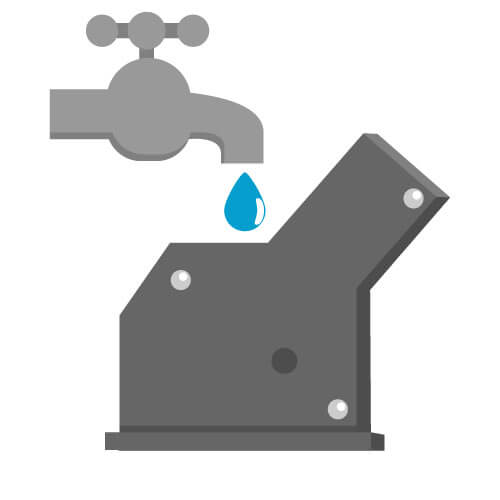
Removable brew groups are particularly easy to clean. Since deposited coffee residues would adulterate the taste, it is advisable to remove them regularly, about once a month, with lukewarm water. Soap and other cleaning agents should be left out so as not to impair the taste permanently.
The inner life
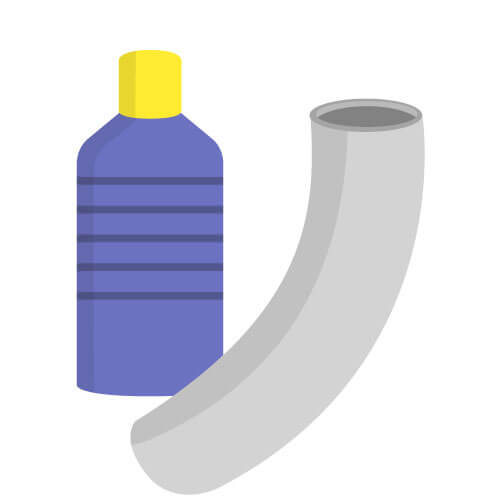
Pathogens such as streptococci and E. coli bacteria collect in a machine that is cleaned too infrequently. Cleaning the hoses and pipes inside the machine therefore requires special grease-dissolving liquids, tablets or powders – ideally without plasticisers, but with additives that seal the surface of the components.
The housing
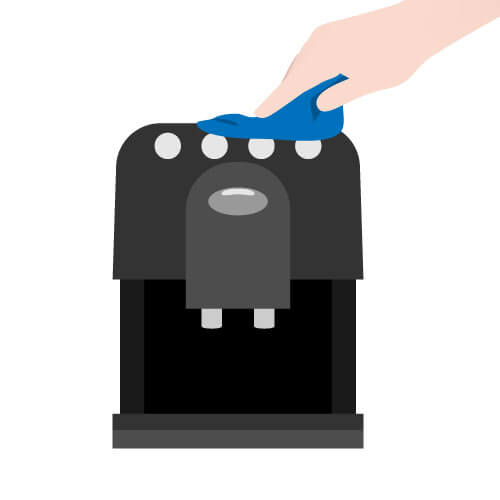
Deposits on the housing can weaken the material over time. For this reason, the exterior of the coffee machine should also be wiped down at least once a month with a damp cloth, but without aggressive cleaning agents.
The coffee grounds container and drip tray
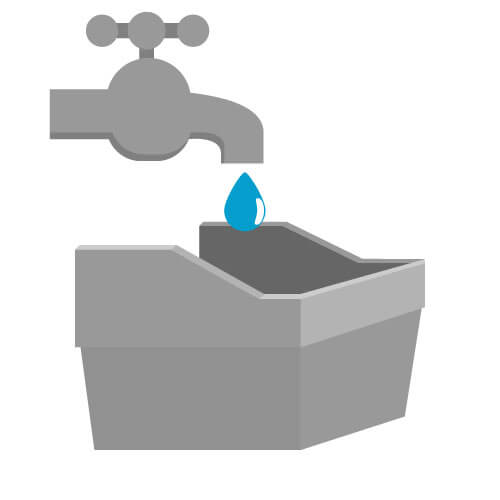
After coffee preparation, the ground and pressed bean residues end up in a collection container that must be emptied regularly. The grounds container and the drip tray are usually easy to remove and clean of coffee and milk residues. To avoid mould, it is best for users to wash out and dry the grounds container daily.
The milk frother
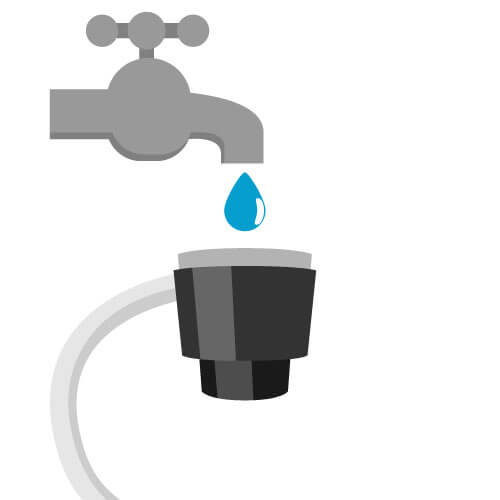
The milk frother is particularly critical in terms of hygiene, because both the steam nozzle and the milk hose are susceptible to blockages, but also bacteria. For this reason, they must be washed daily with hot water.
Regular descaling
Use water filter
If there is no integrated water filter in the coffee machine, it is advisable to always run the tap water through an external water filter first before filling it into the tank.
Depending on the hardness of the water and the strain on the machine, some fully automatic machines need to be descaled more frequently than others. Whereas in the case of rather hard tap water, cleaning is required every few weeks, softer water only means descaling several times a year. After a certain number of cups, the machines automatically remind users that descaling is due. This process is particularly appreciated by users in areas with a high degree of water hardness.
Since fully automatic coffee machines are sensitive devices, users should refrain from any experiments with home remedies and rather use the descalers developed by the manufacturers. These are available either in liquid form or as tablets and are usually based on amidosulfonic acid. If you want a cheaper option, you should consider a descaler from the drugstore that is specifically designed for fully automatic coffee machines. Aggressive home remedies such as vinegar will affect the taste of the coffee and may even cause permanent damage to the equipment material.

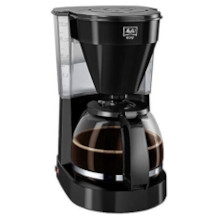
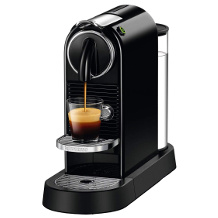

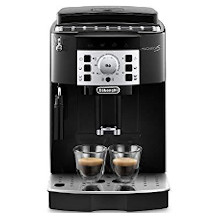
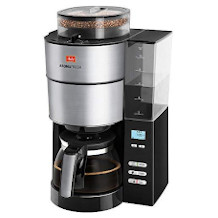
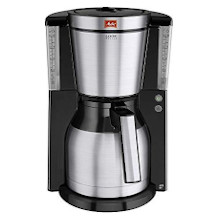
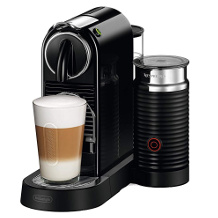
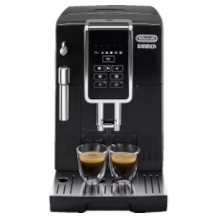
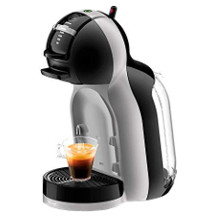
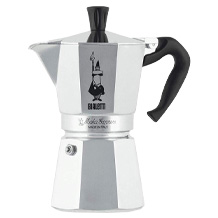

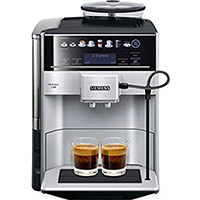


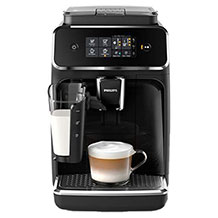
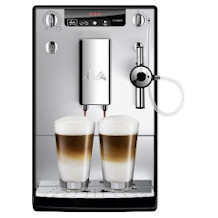

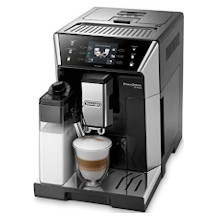
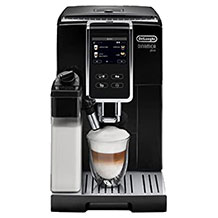
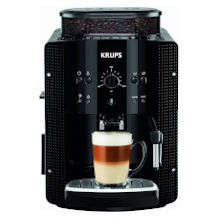

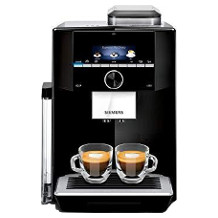
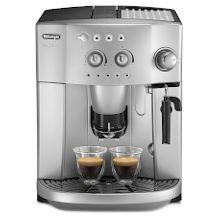




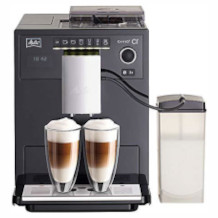

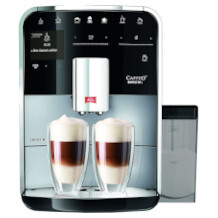



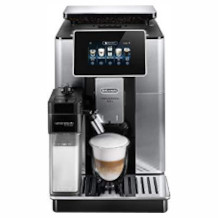

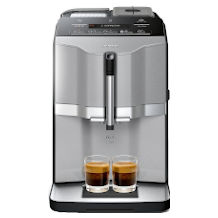

 1,631 reviews
1,631 reviews



